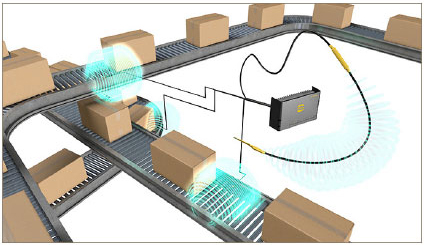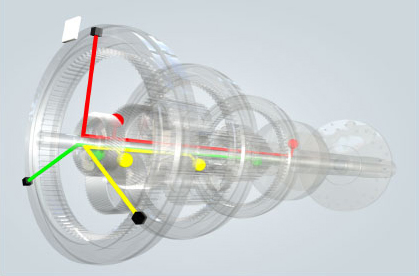- By Ed Garstkiewicz
- Factory Automation
Summary
Fast Forward
- RFID system benefits include preventing product and equipment shortages, tracking parts inventory, and providing up-to-date maintenance history in the field.
- RFID technology can significantly reduce downtime and increase productivity in manufacturing environments.
- Learn steps for implementing an effective RFID system.

RFID technology delivers benefits across many industries
By Ed Garstkiewicz

The reason for this growth is the significant benefits of RFID technology. For example, RFID technology can increase a company's productivity and reliability. By generating real-time data, RFID systems help prevent product and equipment shortages; bring customers reliable, on-time delivery or service; track parts inventory; and provide maintenance history in the field.
This article considers several RFID use cases within the automation environment, explaining why and how an organization should start the process of implementing an RFID system.
Use cases: Where RFID excels
RFID technology can significantly reduce downtime and increase productivity in manufacturing environments when utilized to its full potential. Below are three applications in which RFID particularly excels. Although countless other applications exist, these are some of the most common and trusted use cases for RFID in automation.
Use case 1: Asset management
The most frequent application of RFID technology across all markets is asset management. A common use of RFID in asset tracking is to track a product as it goes through the manufacturing and assembly process. Tracking a product through the logistics chain from manufacturing to warehousing and shipment is also common.
Asset management can extend beyond the manufactured product to tracking tooling, parts, and other items used on the manufacturing floor. For example, as manufacturing processes become more modular, a facility may use multiple molds/cavities or tools for injection molding, machining, or similar manufacturing operations. Tracking these high-cost capital resources may be more valuable than tracking the flow of the actual manufactured product. Of course, RFID can be used to separately track both when needed.
RFID is most effectively used to track items in a dedicated, confined space, such as in a room or through a defined portal. A portal can be anything from a door to a gate on a conveyor or warehouse docking bay. Portals are traditionally created using patch antennas; however, there have been advances in RFID technology that allow very specific and customized portals. For instance, there are antennas that can generate an RF field around the contour of the antenna cable itself (figure 1) allowing a wholly customized field.
Smart shelves or tables are also common means of asset tracking. The system reads the tags as soon as they are placed on or removed from the smart shelf or table. Of course, RFID could also allow full tracking throughout an entire facility, but that requires significantly more hardware and implementation. Using RFID in a dedicated space is cost effective, while still offering all the benefits of an RFID system.

Use case 2: Performance monitoring and control
Performance monitoring, performance metrics, or even process controls can be developed by combining RFID with other common technologies used on the manufacturing floor, like sensors or programmable logic controllers (PLCs). Returning to the modular machine example (such as a stamping or injection molding machine), the RFID infrastructure used to track the modular tooling assets can also act as a process check and control. It ensures that the correct mold/tool combination and necessary program for the job is in place on the machine before the manufacturing process begins. The RFID system communicates with a PLC to control the machine operation based on the correct parameters being in place. Correctly setting up before running the machine prevents costly damage to tools, assets, or the system-as well as preventing unnecessary downtime.
Use case 3: Predictive maintenance
Another powerful implementation of RFID in the automation space is to support predictive maintenance. RFID can link part histories and repair/replacement records directly to the asset. This replaces manually checking serial numbers, inspection records, and logs, thus saving inspection time. With RFID, manual inspection that usually takes hours or even days can be performed in minutes.
RFID further enables predictive maintenance when it is combined with other sensors that measure things like force and temperature. This allows process monitoring and can trigger an alarm or stop when a parameter goes outside of expected limits. RFID tags connected to a thermal sensor in a large motor or gearbox, for example, can track the temperature of rotating elements wirelessly (figure 2). Here, the RFID tags are passive (i.e., they do not require a battery source), which greatly reduces the need for replacing and interrupting the movement of these rotating parts. Crossing an established temperature threshold could indicate the machine is functioning improperly. The machine's control system could then slow down the rotation of the gear or even stop the rotation altogether, avoiding potential damage to a very expensive system.

Business case for RFID
The significant benefits of RFID usually outweigh cost and implementation considerations. Analyzing a particular application and the return on investment (ROI) of RFID helps to develop the business case and plan for its implementation. The section below discusses how to determine if RFID is the right solution and develop such a business case. Below are the three questions this exercise will help answer:
- What kind of internal problem will RFID solve?
- Is RFID the right solution for the specific application?
- How should ROI be calculated?
If a company needs support in answering these questions, an RFID expert or systems integrator can help determine if RFID is the best solution.
Addressing specific problems
Every manager wants to optimize his or her company's operational efficiency. RFID, when implemented correctly, can do just that. The first step is to make sure RFID is the right solution. Consider particular pain points within a business or application by asking:
- Are lost or misrouted assets largely affecting productivity or success?
- Is it hard to find inventory in a plant or warehouse, causing excessive lost work hours or downtime?
- Have there been costs or unscheduled downtime because an incorrect tool damaged a machine?
- Have there been instances when a parameter went out of expected limits, resulting in equipment damage and downtime?
If the answer is yes to any of these questions, RFID is a strong contender as the optimal solution. However, specific problem areas also need to be analyzed, quantified, and given a dollar cost value.
Is RFID the right technology?
Next, it is important to compare RFID technology to other solutions to find out if it is the best solution to a particular problem. One good question to ask is how much data generation is needed and at what frequency. RFID is great for applications that produce constant streams of information. The three use cases considered previously illustrate this perfectly:
- Asset management: The RFID system is integrated into and critical to the manufacturing process, whether that is to track a product from manufacturing to shipping or to track tools and assets in a dedicated area.
- Performance monitoring and process control: The RFID system is integrated with other technologies, such as PLCs or sensors. A system like this can ensure, for example, the correct tool is used with the correct parts to prevent damage and downtime.
- Preventative maintenance: The RFID system stores data that is used to determine when maintenance needs to be performed on a machine. With RFID, the PLC can also trigger an alarm or stop if a tracked parameter goes outside expected limits.
In all three of these examples, RFID constantly gathers and processes information needed for automation system reliability. Some areas would not benefit greatly from RFID compared to less complex solutions, such as barcoding. Understanding where RFID offers the greatest benefits will help companies achieve the greatest ROI.
Calculating ROI
The final step is estimating the ROI to determine how long it will take to see the benefits of the RFID system. First, prepare a complete picture of the investment-including hardware, software, integration, and training. Then, compare that investment to the estimated amount lost by the current problem. This loss should be quantified by the lost dollar amounts caused by downtime, damage to equipment, etc. In many cases, ROI can be achieved in less than 18 months.
RFID ROI should be calculated on the primary pain point; however, companies often find additional uses for RFID that add further value. For example, the accounting team of one company that tracked the usage life cycle of a machine used that information to automatically inventory assets for auditing.
Implementing an RFID system
Understanding all of the components involved, as well as how to kick-start an RFID project, is essential. This final section gives an overview of all the pieces involved in implementing an RFID system. Understanding all the pieces will make starting the process and initial conversations internally or with a systems integrator easier.
Hardware
A successful RFID system requires many properly matched and integrated hardware and software components. From a hardware standpoint, every RFID system requires:
- RFID tags (transponders) that are directly placed on the tracked item
- antennas to create read zones and communicate with the tags as they enter and exit this vicinity
- an RFID reader to send power to the antennas and receive, filter, and process the data from the tags
All of these elements must work together to create a reliable and effective system. Harsh environmental conditions, such as dust, water, humidity, high temperatures, and shock and vibration, pose additional concerns. For these types of environments, special RFID components rated for industry are necessary. Like any product used in a harsh environment, industrial RFID components have standards, such as IP ratings, which indicate their suitability for industrial applications. These are easily found on manufacturers' websites.
Software/middleware
Software is another vital component of any RFID system. There are many different types of software packages that use, access, filter, and analyze the data gathered by the RFID system. Configurable middleware packages are an easy-to-use bridge from the reader to a core information technology (IT) or enterprise resource planning system. It is critical to select software that addresses specific application needs. With the IT team (and an RFID expert or integrator, if needed), review many different software packages to find the best solution for your application.
Integrating the system
Ultimately, the RFID system will need to operate within an existing automation environment. However, putting together RFID hardware and software to create a properly functioning system is a systematic process involving many steps.
It is important to have all the right internal teams onboard with the solution before implementation. One department that is often forgotten is the IT team. The leader of the implementation project needs to be in close contact with the IT team to make sure the system works within the current IT infrastructure.
Proof of concept
The last step before full integration is the proof of concept. Start with a small portion of the project and perform thorough testing. This allows time for any adjustments that need to be made before full integration. For example, the reader or antenna that seemed like the best choice during the planning stage may need to be changed. This stage is critical for efficiency and system reliability in the final deployment.
A successful RFID system can exponentially increase productivity, predict and prevent errors, and minimize downtime. Make sure to consider all aspects-from specific use cases, to the ROI the solution will bring, to all the hardware and software components-to gain all the benefits RFID has to offer.
Reader Feedback
We want to hear from you! Please send us your comments and questions about this topic to InTechmagazine@isa.org.


